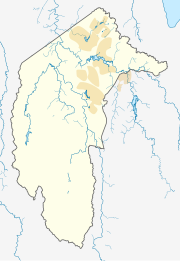| Molonglo Canberra, Australian Capital Territory | |||||||||||||||
|---|---|---|---|---|---|---|---|---|---|---|---|---|---|---|---|
| Coordinates | 35°17′56″S 149°02′31″E / 35.299°S 149.042°E | ||||||||||||||
| Population | 0 (SAL 2021)[1] | ||||||||||||||
| Gazetted | 14 June 2012[2] | ||||||||||||||
| Postcode(s) | 2611 | ||||||||||||||
| Location | 10 km (6 mi) W of Canberra City | ||||||||||||||
| District | Molonglo Valley | ||||||||||||||
| Territory electorate(s) | Murrumbidgee | ||||||||||||||
| Federal division(s) | Bean | ||||||||||||||
| Website | Molonglo | ||||||||||||||
| |||||||||||||||
Molonglo is a suburb currently under development in the Molonglo Valley district of Canberra, Australian Capital Territory, Australia. The suburb of Molonglo derives its name from an Aboriginal expression meaning "the sound of thunder".[3]
YouTube Encyclopedic
-
1/3Views:37 2741 19719 677
-
Canberra, the Capital of Australia
-
Charles Weston School at Coombs
-
Canberra Metro Flythrough
Transcription
Canberra is the purpose built capital city of Australia, located in the Australian Capital Territory in the south-east of New South Wales. It is a planned city, with national monuments, museums, and galleries all built around large man-made lakes. A bush capital - Canberra is also a great place to enjoy the outdoors, with excellent cycling, gardens, parks, bushwalking and nature reserves. Canberra was established in 1913 as the capital for the newly federated Australian nation - this brought the rivalry between Sydney and Melbourne for national capital status to an end, after Melbourne had been the capital for the previous 12 years. The Australian Capital Territory was excised from New South Wales, and put under the control of the federal government. The artificial creation of the city was not without critics - cynics have said that it was a "waste of a good sheep pasture". Canberra is a highly planned city, its primary design conceived by the American architect Walter Burley Griffin, built on the shores of an artificial lake (Lake Burley Griffin). Populated at first largely by politicians and public servants, it took time to develop its own identity and culture. Extensive building of national facilities and a concerted effort to develop public institutions in the city have made it an interesting destination. Lake Burley Griffin divides central Canberra. The central shopping and commercial area, known as "Civic", on the north side and the parliamentary triangle and embassy area is on the south side. National institutions are likewise divided, examples being the National Museum of Australia and the Australian War Memorial on the north side and the National Library and National Gallery of Australia on the south side. There are suburbs surrounding central Canberra, and also suburbs surrounding several outlying town centres. These town centres are, Belconnen and Gungahlin to the north, and Molonglo Valley, Tuggeranong and Woden to the south. The Australian Capital Territory also has surrounding towns, such as Murrumbateman, which boasts a strong cool climate wine selection. The historic villages of Hall and Tharwa are also on the outskirts of Canberra. Many people who live in Canberra are not originally from Canberra, having usually moved there to study or take up employment with the Australian Government. A common pattern is that people from other parts of Australia move to Canberra, study or work for a few years and then return to their place of origin or move on to elsewhere. As this means a constant influx of new arrivals to Canberra, you should not be reluctant to ask for directions and the like from locals - they are more than used to it and usually only too happy to help.
Location and urban structure
Currently in development and planning stages, Molonglo is expected to be the town centre or group centre and will comprise the principal commercial and civic centre for the Molonglo Valley district. It is planned to accommodate approximately 1000 new dwellings in a relatively compact mixed use urban environment.[4]
Features
Molonglo is a cat containment area, as are other new suburbs in the vicinity.[5]
Geology
The suburb of Molonglo is split by an east–west direction fault that splays off the Winslade Fault. This fault is marked by quartz. The south side has been thrown down, and the north side elevated. This fault crosses the Molonglo River at the point where it goes in a tight bend from east to north west. This point also has one other fault crossing and another fault terminating. The rock south of the east–west fault is rhyodacite from the Deakin Volcanics, and to the north are the older Mount Painter Volcanics with tuff composed of dacite fragments.[6]
References
- ^ Australian Bureau of Statistics (28 June 2022). "Molonglo (suburb and locality)". Australian Census 2021 QuickStats. Retrieved 28 June 2022.
- ^ "Search for street and suburb names: Molonglo". Environment and Sustainable Development Directorate. ACT Government. 4 December 2013. Retrieved 22 December 2013.
- ^ Sharaz, David (15 June 2012). "Denman Prospect and Molonglo: our newest suburbs". The Canberra Times. Retrieved 22 December 2013.
- ^ "Current project: Molonglo Stage 2". Environment and Sustainable Development Directorate. ACT Government. 23 September 2013. Retrieved 22 December 2013.
- ^ "Geocortex Viewer for HTML5". ACT Government. Select Domestic Animals map, can tick the cat containment layer.
- ^ Henderson G A M and Matveev G, Geology of Canberra, Queanbeyan and Environs 1:50000 1980.

